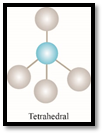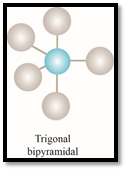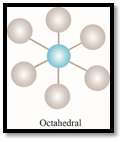
EBK GENERAL CHEMISTRY: THE ESSENTIAL CO
7th Edition
ISBN: 9780100257047
Author: Chang
Publisher: YUZU
expand_more
expand_more
format_list_bulleted
Concept explainers
Question
Chapter 10, Problem 10.3QP
Interpretation Introduction
Interpretation:
The number of atoms bonded directly to the central atom of tetrahedral molecule, trigonal bipyramidal molecule and octahedral molecule should be determined.
Concept introduction:
- Tetrahedralgeometry,

Figure 1
- Trigonal bipyramidal geometry,

Figure 2
- Octahedral geometry,

Figure 3
Expert Solution & Answer
Want to see the full answer?
Check out a sample textbook solution
Students have asked these similar questions
Draw the formula of the product obtained by reacting adipic acid 1st with PCl5 and 2nd treatment with NH3.
please help me with my homework
help
Chapter 10 Solutions
EBK GENERAL CHEMISTRY: THE ESSENTIAL CO
Ch. 10.1 - Practice Exercise Use the VSEPR model to predict...Ch. 10.1 - Review of Concepts
Which of the following...Ch. 10.2 - Prob. 1PECh. 10.2 - Prob. 1RCCh. 10.3 - Prob. 1RCCh. 10.4 - Prob. 1PECh. 10.4 - Prob. 2PECh. 10.4 - Prob. 1RCCh. 10.5 - Prob. 1PECh. 10.5 - Prob. 1RC
Ch. 10.6 - Prob. 1RCCh. 10.6 - Prob. 2RCCh. 10.6 - Prob. 1PECh. 10 - Prob. 10.1QPCh. 10 - Prob. 10.2QPCh. 10 - 10.3 How many atoms arc directly bonded to the...Ch. 10 - 10.4 Discuss the basic features of the VSEPR...Ch. 10 - 10.5 In the trigonal bipyramidal arrangement, why...Ch. 10 - 10.6 The geometry of CH4 could be square planar,...Ch. 10 - Prob. 10.7QPCh. 10 - Prob. 10.8QPCh. 10 - Prob. 10.9QPCh. 10 - Prob. 10.10QPCh. 10 - 10.11 Describe the geometry around each of the...Ch. 10 - 10.12 Which of these species are tetrahedral?...Ch. 10 - 10.13 Define dipole moment. What are the units and...Ch. 10 - 10.14 What is the relationship between the dipole...Ch. 10 - 10.15 Explain why an atom cannot have a permanent...Ch. 10 - 10.16 The bonds in beryllium hydride (BeH2)...Ch. 10 - 10.17 Referring to Table 10.3. arrange the...Ch. 10 - 10.18 The dipole moments of the hydrogen halides...Ch. 10 - 10.19 List these molecules in order of increasing...Ch. 10 - 10.20 Docs the molecule OCS have a higher or lower...Ch. 10 - 10.21 Which of these molecules has a higher dipole...Ch. 10 - 10.22 Arrange these compounds in order of...Ch. 10 - 10.23 What is valence bond theory? How does it...Ch. 10 - 10.24 Use valence bond theory to explain the...Ch. 10 - 10.25Draw a potential energy curve for the bond...Ch. 10 - 10.26 What is the hybridization of atomic...Ch. 10 - 10.27 How does a hybrid orbital differ from a pure...Ch. 10 - 10.28 What is the angle between these two hybrid...Ch. 10 - 10.29 How would you distinguish between a sigma...Ch. 10 - 10.30 Which of these pairs of atomic orbitals of...Ch. 10 - 10.31 The following potential energy curve...Ch. 10 - 10.32 What is the hybridization state of Si in...Ch. 10 - 10.33 Describe the change in hybridization (if...Ch. 10 - 10.34 Consider the reaction
Describe the changes...Ch. 10 - 10.35 What hybrid orbitals are used by nitrogen...Ch. 10 - Prob. 10.36QPCh. 10 - 10.37 Specify which hybrid orbitals are used by...Ch. 10 - 10.38 What is the hybridization state of the...Ch. 10 - 10.39 The allene molecule H2C=C=CH2 is linear (the...Ch. 10 - 10.40 Describe the hybridization of phosphorus in...Ch. 10 - 10.41 How many sigma bonds and pi bonds are there...Ch. 10 - 10.42 How many pi bonds and sigma bonds are there...Ch. 10 - 10.43 Give the formula of a cation comprised of...Ch. 10 - 10.44 Give the formula of an anion comprised of...Ch. 10 - 10.45 What is molecular orbital theory? How does...Ch. 10 - 10.46 Define these terms: bonding molecular...Ch. 10 - 10.47 Sketch the shapes of these molecular...Ch. 10 - 10.48 Explain the significance of bond order. Can...Ch. 10 - 10.49 Explain in molecular orbital terms the...Ch. 10 - Prob. 10.50QPCh. 10 - Prob. 10.51QPCh. 10 - Prob. 10.52QPCh. 10 - Prob. 10.53QPCh. 10 - Prob. 10.54QPCh. 10 - Prob. 10.55QPCh. 10 - 10.56 Compare the Lewis and molecular orbital...Ch. 10 - Prob. 10.57QPCh. 10 - 10.58 Compare the relative stability of these...Ch. 10 - Prob. 10.59QPCh. 10 - Prob. 10.60QPCh. 10 - Prob. 10.61QPCh. 10 - Prob. 10.62QPCh. 10 - Prob. 10.63QPCh. 10 - Prob. 10.64QPCh. 10 - Prob. 10.65QPCh. 10 - Prob. 10.66QPCh. 10 - Prob. 10.67QPCh. 10 - Prob. 10.68QPCh. 10 - 10.69 Draw Lewis structures and give the other...Ch. 10 - Prob. 10.70QPCh. 10 - Prob. 10.71QPCh. 10 - Prob. 10.72QPCh. 10 - Prob. 10.73QPCh. 10 - Prob. 10.74QPCh. 10 - Prob. 10.75QPCh. 10 - Prob. 10.76QPCh. 10 - Prob. 10.77QPCh. 10 - Prob. 10.78QPCh. 10 - Prob. 10.79QPCh. 10 - Prob. 10.80QPCh. 10 - Prob. 10.81QPCh. 10 - Prob. 10.82QPCh. 10 - Prob. 10.83QPCh. 10 - 10.84 The ionic character of the bond in a...Ch. 10 - Prob. 10.85QPCh. 10 - 10.86 Aluminum trichloride (AlCl3) is an...Ch. 10 - Prob. 10.87QPCh. 10 - Prob. 10.88QPCh. 10 - 10.90 Progesterone is a hormone responsible for...Ch. 10 - Prob. 10.91SPCh. 10 - Prob. 10.92SPCh. 10 - Prob. 10.93SPCh. 10 - 10.94 The molecule benzyne (C6H4) is a very...Ch. 10 - Prob. 10.95SPCh. 10 - 10.96 As mentioned in the chapter, the Lewis...Ch. 10 - Prob. 10.97SPCh. 10 - Prob. 10.98SPCh. 10 - Prob. 10.99SPCh. 10 - Prob. 10.100SPCh. 10 - Prob. 10.101SPCh. 10 - Prob. 10.102SP
Knowledge Booster
Learn more about
Need a deep-dive on the concept behind this application? Look no further. Learn more about this topic, chemistry and related others by exploring similar questions and additional content below.Similar questions
- The temperature on a sample of pure X held at 1.25 atm and -54. °C is increased until the sample boils. The temperature is then held constant and the pressure is decreased by 0.42 atm. On the phase diagram below draw a path that shows this set of changes. pressure (atm) 2 0 0 200 400 temperature (K) Xarrow_forwardQUESTION: Answer Question 5: 'Calculating standard error of regression' STEP 1 by filling in all the empty green boxes *The values are all provided in the photo attached*arrow_forwardpressure (atm) 3 The pressure on a sample of pure X held at 47. °C and 0.88 atm is increased until the sample condenses. The pressure is then held constant and the temperature is decreased by 82. °C. On the phase diagram below draw a path that shows this set of changes. 0 0 200 temperature (K) 400 аarrow_forward
- er your payment details | bar xb Home | bartleby x + aleksogi/x/isl.exe/1o u-lgNskr7j8P3jH-1Qs_pBanHhviTCeeBZbufuBYT0Hz7m7D3ZcW81NC1d8Kzb4srFik1OUFhKMUXzhGpw7k1 O States of Matter Sketching a described thermodynamic change on a phase diagram 0/5 The pressure on a sample of pure X held at 47. °C and 0.88 atm is increased until the sample condenses. The pressure is then held constant and the temperature is decreased by 82. °C. On the phase diagram below draw a path that shows this set of changes. pressure (atm) 1 3- 0- 0 200 Explanation Check temperature (K) 400 X Q Search L G 2025 McGraw Hill LLC. All Rights Reserved Terms of Use Privacy Cearrow_forward5.arrow_forward6.arrow_forward
- 0/5 alekscgi/x/sl.exe/1o_u-IgNglkr7j8P3jH-IQs_pBaHhvlTCeeBZbufuBYTi0Hz7m7D3ZcSLEFovsXaorzoFtUs | AbtAURtkqzol 1HRAS286, O States of Matter Sketching a described thermodynamic change on a phase diagram The pressure on a sample of pure X held at 47. °C and 0.88 atm is increased until the sample condenses. The pressure is then held constant and the temperature is decreased by 82. °C. On the phase diagram below draw a path that shows this set of changes. 3 pressure (atm) + 0- 0 5+ 200 temperature (K) 400 Explanation Check X 0+ F3 F4 F5 F6 F7 S 2025 McGraw Hill LLC All Rights Reserved. Terms of Use Privacy Center Accessibility Q Search LUCR + F8 F9 F10 F11 F12 * % & ( 5 6 7 8 9 Y'S Dele Insert PrtSc + Backsarrow_forward5.arrow_forward9arrow_forward
- alekscgi/x/lsl.exe/1o_u-IgNslkr7j8P3jH-IQs_pBanHhvlTCeeBZbufu BYTI0Hz7m7D3ZS18w-nDB10538ZsAtmorZoFusYj2Xu9b78gZo- O States of Matter Sketching a described thermodynamic change on a phase diagram 0/5 The pressure on a sample of pure X held at 47. °C and 0.88 atm is increased until the sample condenses. The pressure is then held constant and the temperature is decreased by 82. °C. On the phase diagram below draw a path that shows this set of changes. pressure (atm) 3- 200 temperature (K) Explanation Chick Q Sowncharrow_forward0+ aleksog/x/lsl.exe/1ou-lgNgkr7j8P3H-IQs pBaHhviTCeeBZbufuBYTOHz7m7D3ZStEPTBSB3u9bsp3Da pl19qomOXLhvWbH9wmXW5zm O States of Matter Sketching a described thermodynamic change on a phase diagram 0/5 Gab The temperature on a sample of pure X held at 0.75 atm and -229. °C is increased until the sample sublimes. The temperature is then held constant and the pressure is decreased by 0.50 atm. On the phase diagram below draw a path that shows this set of changes. F3 pressure (atm) 0- 0 200 Explanation temperature (K) Check F4 F5 ☀+ Q Search Chill Will an 9 ENG F6 F7 F8 F9 8 Delete F10 F11 F12 Insert PrtSc 114 d Ararrow_forwardx + LEKS: Using a phase diagram a X n/alekscgi/x/lsl.exe/10_u-IgNsikr7j8P3jH-IQs_pBan HhvlTCeeBZbufu BYTI0Hz7m7D3ZcHYUt80XL-5alyVpw ○ States of Matter Using a phase diagram to find a phase transition temperature or pressure Use the phase diagram of Substance X below to find the melting point of X when the pressure above the solid is 1.1 atm. pressure (atm) 16 08- solid liquid- 0 200 400 gas 600 temperature (K) Note: your answer must be within 25 °C of the exact answer to be graded correct. × 5arrow_forward
arrow_back_ios
SEE MORE QUESTIONS
arrow_forward_ios
Recommended textbooks for you
 ChemistryChemistryISBN:9781305957404Author:Steven S. Zumdahl, Susan A. Zumdahl, Donald J. DeCostePublisher:Cengage Learning
ChemistryChemistryISBN:9781305957404Author:Steven S. Zumdahl, Susan A. Zumdahl, Donald J. DeCostePublisher:Cengage Learning ChemistryChemistryISBN:9781259911156Author:Raymond Chang Dr., Jason Overby ProfessorPublisher:McGraw-Hill Education
ChemistryChemistryISBN:9781259911156Author:Raymond Chang Dr., Jason Overby ProfessorPublisher:McGraw-Hill Education Principles of Instrumental AnalysisChemistryISBN:9781305577213Author:Douglas A. Skoog, F. James Holler, Stanley R. CrouchPublisher:Cengage Learning
Principles of Instrumental AnalysisChemistryISBN:9781305577213Author:Douglas A. Skoog, F. James Holler, Stanley R. CrouchPublisher:Cengage Learning Organic ChemistryChemistryISBN:9780078021558Author:Janice Gorzynski Smith Dr.Publisher:McGraw-Hill Education
Organic ChemistryChemistryISBN:9780078021558Author:Janice Gorzynski Smith Dr.Publisher:McGraw-Hill Education Chemistry: Principles and ReactionsChemistryISBN:9781305079373Author:William L. Masterton, Cecile N. HurleyPublisher:Cengage Learning
Chemistry: Principles and ReactionsChemistryISBN:9781305079373Author:William L. Masterton, Cecile N. HurleyPublisher:Cengage Learning Elementary Principles of Chemical Processes, Bind...ChemistryISBN:9781118431221Author:Richard M. Felder, Ronald W. Rousseau, Lisa G. BullardPublisher:WILEY
Elementary Principles of Chemical Processes, Bind...ChemistryISBN:9781118431221Author:Richard M. Felder, Ronald W. Rousseau, Lisa G. BullardPublisher:WILEY

Chemistry
Chemistry
ISBN:9781305957404
Author:Steven S. Zumdahl, Susan A. Zumdahl, Donald J. DeCoste
Publisher:Cengage Learning

Chemistry
Chemistry
ISBN:9781259911156
Author:Raymond Chang Dr., Jason Overby Professor
Publisher:McGraw-Hill Education

Principles of Instrumental Analysis
Chemistry
ISBN:9781305577213
Author:Douglas A. Skoog, F. James Holler, Stanley R. Crouch
Publisher:Cengage Learning

Organic Chemistry
Chemistry
ISBN:9780078021558
Author:Janice Gorzynski Smith Dr.
Publisher:McGraw-Hill Education

Chemistry: Principles and Reactions
Chemistry
ISBN:9781305079373
Author:William L. Masterton, Cecile N. Hurley
Publisher:Cengage Learning

Elementary Principles of Chemical Processes, Bind...
Chemistry
ISBN:9781118431221
Author:Richard M. Felder, Ronald W. Rousseau, Lisa G. Bullard
Publisher:WILEY
Stoichiometry - Chemistry for Massive Creatures: Crash Course Chemistry #6; Author: Crash Course;https://www.youtube.com/watch?v=UL1jmJaUkaQ;License: Standard YouTube License, CC-BY
Bonding (Ionic, Covalent & Metallic) - GCSE Chemistry; Author: Science Shorts;https://www.youtube.com/watch?v=p9MA6Od-zBA;License: Standard YouTube License, CC-BY
General Chemistry 1A. Lecture 12. Two Theories of Bonding.; Author: UCI Open;https://www.youtube.com/watch?v=dLTlL9Z1bh0;License: CC-BY